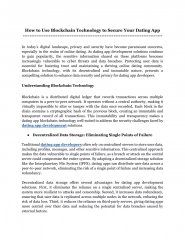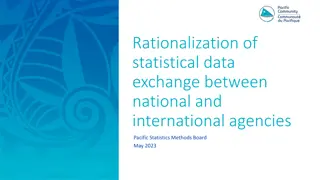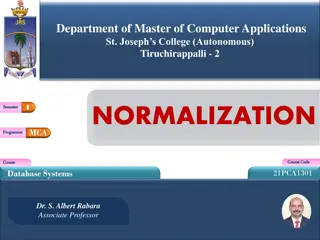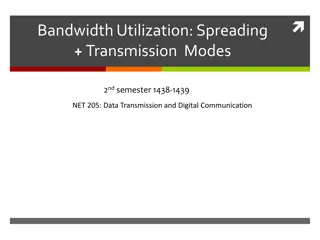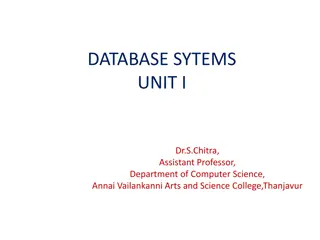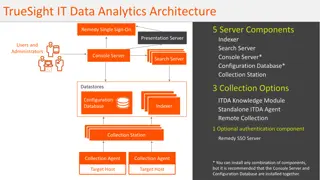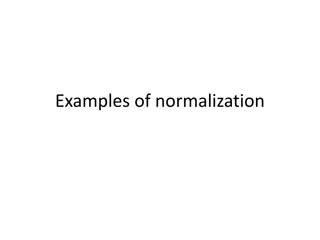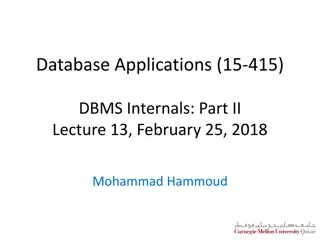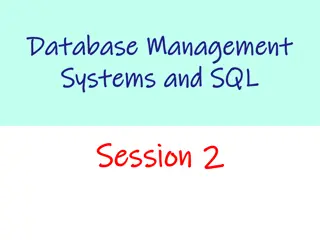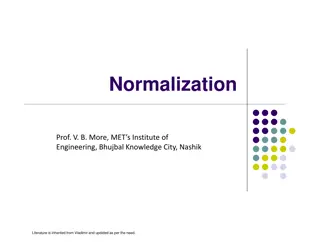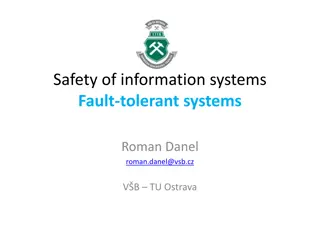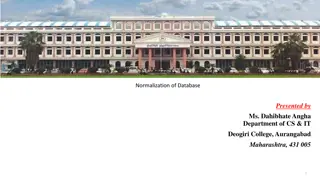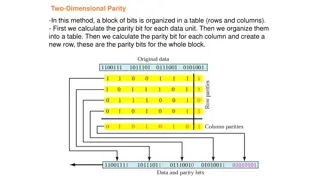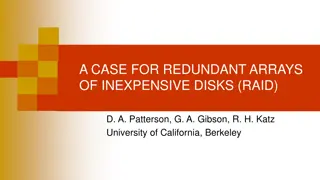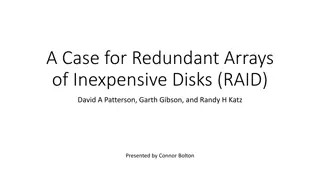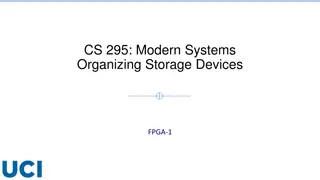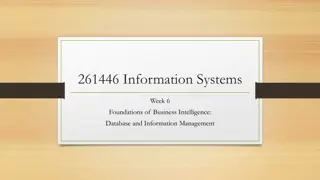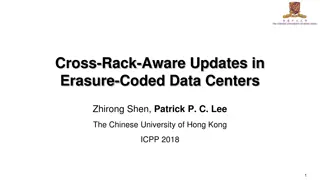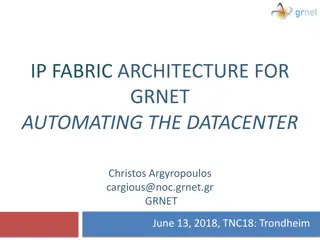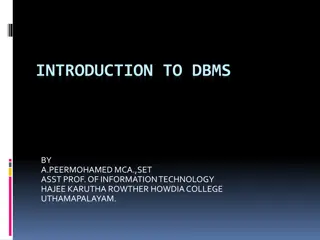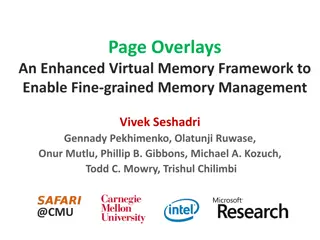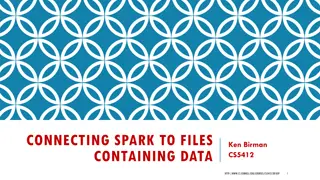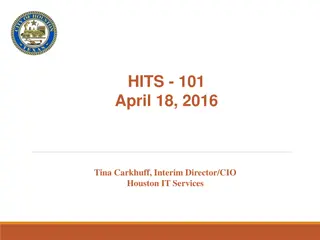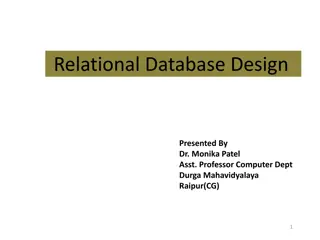Redundancy Masterclass: 8 Tricky Issues and How to Deal with Them
How to handle challenging aspects of redundancy, including employees on maternity leave, discriminatory selection criteria, targeting expensive employees, scoring adjustments for disabled employees, employee disputes, disabled employees at risk, and persuading the board.
0 views • 21 slides
How to Use Blockchain Technology to Secure Your Dating App Data
Discover the transformative power of blockchain technology in securing data for dating app development solutions. Eliminate single points of failure with decentralized storage, boosting redundancy. Ensure immutable integrity, preventing unauthorized modifications to user data. Facilitate secure mess
1 views • 4 slides
Power Distribution in Data Centers Overview
Power distribution and equipment play crucial roles in commercial data center infrastructure, ensuring reliable and efficient operations. Adequate power routing from the grid or generators to data center equipment is vital for stable operations, data integrity, and performance maintenance. This incl
4 views • 19 slides
Rationalization of statistical data exchange between national and international agencies
The discussion revolves around rationalizing statistical data exchange processes between national and international agencies, focusing on the challenges, principles, and proposed strategies to streamline reporting and dissemination. Key points include the complexity of data flows, burden of internat
1 views • 10 slides
Ask On Data for Efficient Data Wrangling in Data Engineering
In today's data-driven world, organizations rely on robust data engineering pipelines to collect, process, and analyze vast amounts of data efficiently. At the heart of these pipelines lies data wrangling, a critical process that involves cleaning, transforming, and preparing raw data for analysis.
2 views • 2 slides
Introduction to Database Management System Explained
This presentation covers the basics of database management systems, including definitions of data, types of data, structured and unstructured data, storing data in computers using file systems and database systems, and issues with file systems like data redundancy, inconsistency, difficult data acce
1 views • 18 slides
Understanding Database Normalization and Functional Dependencies
Database normalization is a crucial process that aims to improve database design by organizing data into higher forms of normality. This helps in reducing redundancy and ensuring data integrity. Functional dependencies play a key role in defining relationships between attributes in a database. By un
0 views • 33 slides
Understanding Spread Spectrum Techniques in Data Transmission
Explore the concepts of bandwidth utilization, spreading, and transmission modes in data transmission and digital communication. Learn about spread spectrum techniques such as frequency hopping and direct sequence spread spectrum, which enable efficient sharing of wireless communication channels. Di
1 views • 28 slides
Understanding Database Systems in IT
Database systems play a crucial role in managing and organizing data efficiently. They provide a structured environment for storing and accessing information, enabling various applications in sectors like banking, airlines, universities, sales, and more. The transition from traditional file systems
3 views • 38 slides
TrueSight IT Data Analytics Architecture Overview
TrueSight IT Data Analytics Architecture provides a comprehensive framework for collecting, indexing, and analyzing data from target hosts. Components like Console Server, Configuration Database, Collection Agents, and more work together to ensure efficient data processing and storage. The architect
0 views • 12 slides
Understanding Redundancy in the Workplace
This 3-day course on dealing with redundancy covers topics such as the definition of redundancy, employee rights, consultation processes, alternatives to redundancy, and more. Participants engage in activities to discuss tasks related to redundancy and explore the Employment Rights Act 1996. The cou
0 views • 15 slides
Understanding Database Normalization Process
Database normalization is a crucial process that helps in organizing data efficiently by reducing redundancy and dependency issues. It involves steps like identifying keys, removing repeating attributes, and transforming data into different normal forms. Each step aims to enhance data integrity and
0 views • 19 slides
Understanding RAID Technology in DBMS: Redundancy and Performance
This content provides insights into RAID technology, discussing the combination of reliability and performance in managing multiple disks through various RAID levels like RAID 0, RAID 1, RAID 2, RAID 3, RAID 4, and RAID 5. It explores the advantages of RAID, such as data striping, mirroring, bit int
0 views • 61 slides
Update on Negotiated Rulemaking Committee (NRMC) Recommendations for Higher Education Data Requests
The update covers the proceedings and recommendations of the Negotiated Rulemaking Committee (NRMC) regarding data requests in higher education. The NRMC, formed under Texas Education Code, reviewed and proposed modifications to 93 data requests, aiming to streamline and optimize data collection pro
1 views • 24 slides
Global Relevance and Redundancy Optimization in Multi-label Feature Selection
The study focuses on optimizing multi-label feature selection by balancing global relevance and redundancy factors, aiming to enhance the efficiency and accuracy of data analysis. It delves into the challenges posed by information theoretical-based methods and offers insights on overcoming limitatio
0 views • 15 slides
Understanding Database Management Systems and Keys in SQL
This content discusses the importance of organizing data into multiple tables within a database management system, the concept of keys and foreign keys, and the potential issues of data redundancy. It also covers examples of structured data related to products, orders, and manufacturers.
0 views • 55 slides
Understanding Normalization in Database Management
Normalization is a crucial database design technique used to organize tables efficiently, reduce data redundancy, and prevent anomalies in data operations. This process involves decomposing larger tables into smaller, linked tables to ensure consistency and ease of data management.
1 views • 59 slides
Understanding Fault-Tolerant Systems and Data Recovery Strategies
Explore the concepts of fault-tolerant systems, disaster recovery, high availability, and database technologies for ensuring the safety of information systems. Learn about uptime, downtime, MTBF, and MTTR, along with IBM's disaster recovery layers and solutions like redundancy, replication, and dive
1 views • 27 slides
Understanding Database Normalization: A Comprehensive Guide
Database normalization is a crucial process in database design to eliminate data redundancy and anomalies. This guide covers the definition of normalization, types of normalization including 1NF, 2NF, and more, along with examples and explanations on achieving each normalization form.
1 views • 22 slides
Understanding Database Normalization Techniques
Database normalization is a crucial technique for organizing data efficiently to eliminate redundancy and anomalies. It involves decomposing tables to ensure data integrity and minimize inconsistencies. Common issues without normalization include excessive memory usage and data manipulation problems
4 views • 21 slides
Optimizing Ethernet Communication with PRP and HSR Redundancy Protocols
Explore how to optimize Ethernet communication using Parallel Redundancy Protocol (PRP) and High-availability Seamless Redundancy (HSR) protocols. PRP is ideal for connecting a large number of IEDs with the same application, while HSR is preferred for smaller networks with a single ring topology. Di
0 views • 23 slides
Data Error Detection Techniques Overview
Two-dimensional parity and Cyclic Redundancy Check (CRC) are data error detection methods used to ensure data integrity during transmission. Two-dimensional parity involves organizing bits in a table to calculate parity bits for data units and columns, while CRC appends a string of zeros to the data
0 views • 20 slides
Understanding Redundant Arrays of Inexpensive Disks (RAID)
This informative material discusses the concept of RAID, its various levels such as RAID 0, 1, and 2, their advantages and disadvantages, and the motivation behind implementing RAID systems. It highlights the need for data redundancy, disk throughput optimization, and reliable storage solutions usin
0 views • 30 slides
Understanding RAID: A Case for Redundant Arrays of Inexpensive Disks
Delve into the world of Redundant Arrays of Inexpensive Disks (RAID) exploring its evolution, motivation, and various RAID levels like RAID 1, RAID 2, RAID 3, and RAID 4. Discover the importance of data redundancy and fault tolerance in storage systems.
0 views • 17 slides
Understanding RAID 5 Technology: Fault Tolerance and Degraded Mode
RAID 5 is a popular technology for managing multiple storage devices within a single array, providing fault tolerance through data striping and parity blocks. This article discusses the principles of fault tolerance in RAID 5, the calculation of parity blocks, handling degraded mode in case of disk
0 views • 12 slides
Foundations of Business Intelligence: Traditional Data Organization Challenges
In this module, we delve into the importance of high-quality data and the challenges faced by businesses in managing traditional data organization. Discover how the use of databases can enhance business performance and decision-making while addressing issues like data redundancy and inconsistency.
0 views • 56 slides
Understanding Reed-Solomon Encoding: Basics and Applications
Messages consist of symbols from an alphabet and can face erasures and errors during transmission/storage. Redundancy is introduced in codewords to handle these faults, with schemes like 2x and 3x redundancy. Parity bits help detect/correct errors in binary messages efficiently, offering a cost-effe
0 views • 130 slides
Understanding Matching Keys in Database Systems
Matching keys play a crucial role in identifying the same real-world entities in database systems. They specify which attributes to compare and how to compare them, helping minimize redundancy and improve data accuracy. This summary discusses relative candidate keys, minimal matching keys, and relia
0 views • 13 slides
Cross-Rack-Aware Updates in Erasure-Coded Data Centers
Erasure coding is a fault-tolerance technique used in modern data centers to minimize data redundancy and increase reliability. This paper explores practical updates in erasure coding, highlighting the challenges of high update penalties and proposing cross-rack-aware strategies to mitigate cross-ra
0 views • 22 slides
Improving Wireless Performance Through Content Overhearing Refactoring
Explore the concept of refactoring content overhearing to enhance wireless performance by focusing on throughput, leveraging overheard packets, suppressing duplicate data, and identifying sub-packet redundancy. Benefits of this approach include operating at finer granularity, redundancy elimination
0 views • 30 slides
Enhancing Erasure-Coded Storage with Repair Pipelining
Erasure coding is a powerful redundancy technique for distributed storage systems, offering fault tolerance and reduced redundancy compared to replication. This paper discusses the concept of erasure coding, its practical applications, and challenges such as repair penalties. It explores innovative
0 views • 21 slides
IP Fabric Architecture for GRNET Datacenters: Automating the Future
GRNET is expanding its data center infrastructure to address existing problems, balance tested and innovative solutions, and enable VLAN stretching between data centers. The new architecture aims to enhance network efficiency and scalability by implementing an IP Fabric solution. Previous architectu
0 views • 19 slides
Understanding Database Management Systems (DBMS): A Comprehensive Overview
This comprehensive overview of Database Management Systems (DBMS) covers the definition, environment, advantages, limitations, and characteristics of data in a database. It delves into the hardware and software components, user roles, and benefits of using a DBMS. The content highlights the control
0 views • 25 slides
Proposed Re-Alignment of College Standing Committees for Enhanced Shared Governance
The presentation outlines the objectives of a proposed re-alignment of college standing committees to strengthen shared governance by enhancing campus-wide participation, eliminating redundancy, and aligning data with decision-making processes. It highlights the structure of the College Council and
0 views • 8 slides
Enhanced Virtual Memory Framework for Fine-grained Memory Management
This study introduces Page Overlays, a new virtual memory framework designed to enable fine-grained memory management. By efficiently storing pages with similar data and providing powerful access semantics, Page Overlays improve performance and reduce memory redundancy compared to existing virtual m
0 views • 29 slides
Lazy Code Motion and Partial Redundancy Elimination in Optimizing Compiler
Lazy code motion, partial redundancy elimination, common subexpression elimination, and loop invariant code motion are optimization techniques used in compilers to improve code efficiency by eliminating redundant computations and moving code blocks to optimize performance. These techniques aim to de
0 views • 35 slides
Connecting Spark to Files Containing Data - Overview of RDD Model Expansion
Today's lecture explores the evolution of Spark from its inception at Berkeley to its widespread adoption globally. The focus is on the RDD model, which has transitioned into a full programming language resembling SQL, Python, or Scala. Examples of RDD programming at Cornell and in industry settings
0 views • 53 slides
Understanding HITS: Connecting Data Centers, Applications, and Redundancy
Explore how HITS interconnects data centers, supported applications, and redundancy strategies in IT services. Learn about network diagrams, tier level requirements for data centers, supported applications by department, and the SAP ecosystem. Dive into concepts like redundancy versus non-redundancy
0 views • 8 slides
Understanding Relational Database Design Fundamentals
This content delves into the crucial aspects of relational database design, including normalization, pitfalls, RDBMS design issues, and the overall database design process. It emphasizes the need for well-structured relation schemas to minimize redundancy, ensure data integrity, and facilitate effic
1 views • 53 slides
Low-Redundancy Proactive Fault Tolerance for Stream Machine Learning
This study focuses on enabling fault tolerance for stream machine learning through erasure coding. Fault tolerance is crucial in distributed environments due to worker failures, and existing approaches like reactive fault tolerance and proactive replication have drawbacks. The use of erasure coding
0 views • 20 slides

